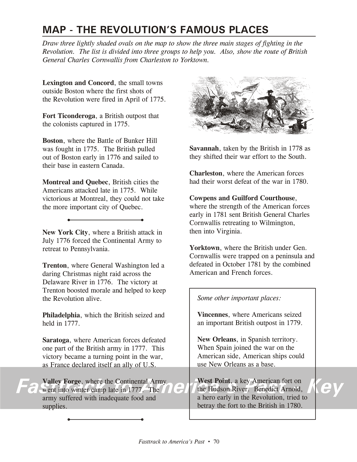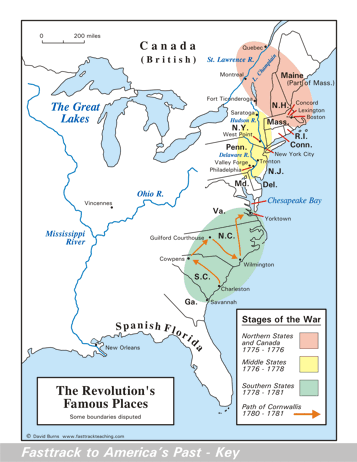| Fasttrack
to America's Past Teacher Key |
|
| Fasttrack
to America's Past Teacher Key |
|
 Page 70  Page 71 The map is shown
as it appears when completed by students using color
pencils. The
full size map that students will use to guide their work can be found
with the link on the main index page for this section.
Please read the "Tips for completing the map" in the next column. |
Pages 70
& 71 - Map - The Revolution's Famous Places Map guide, page 70 This page has no blanks for students to complete. Students should instead study the information by reading carefully as they locate and point to the locations on the map. The picture The drawing shows George
Washington moving his men during the battles in August 1776 for
control of New York City. The American army was forced to
retreat,
and the British held the city for the rest of the war. Students should work from the finished map shown with the link from this section's main index page. Emphasize neatness from the beginning! Ask students to color the rivers, lakes, and
the Chesapeake
Bay first. Use blue for the rivers, and light blue for the lakes
and the bay. Point out Lake Champlain - it's easy for students to
miss it. Tell students to very carefully draw the three color ovals with color pencils, matching the colors to the key. The outline and shading must be done very lightly so the map places remain visible. Finally, students should color the Atlantic Ocean and Gulf of Mexico with a light blue color pencil.
|
|
Copyright Notice
Copyright 2018 by David Burns. All rights reserved. Illustrations and reading selections appearing in this work are taken from sources in the public domain and from private collections used by permission. Sources include: the Dover Pictorial Archive, the Library of Congress, The National Archives, The Hart Publishing Co., Corel Corporation and its licensors, Nova Development Corporation and its licensors, and others. Maps were created or adapted by the author using reference maps from the United States Geological Survey and Cartesia Software. Please see the home page for this title for more information. |